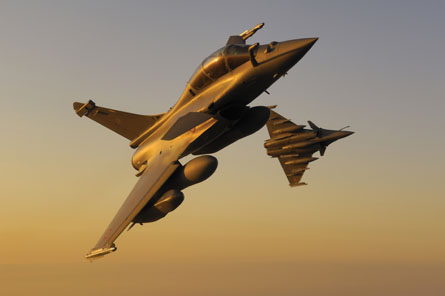With India prominently labelled as the show’s ‘official partner country’, the importance of the Indian market, and the growing power of India’s aerospace industry is being underlined and highlighted at Schoenefeld. Jon Lake reports
With the recent, long awaited release of a $10 billion request for proposals (RFP), India’s Medium Multi-Role Combat Aircraft (MMRCA) competition is hotting up, and the main contenders are all present at Berlin, doubtless hoping to impress and persuade India that theirs is the best choice as India’s next fighter.
Originally launched as the Multi-Role Combat Aircraft (MRCA) requirement, the Indian fighter competition originally sought a replacement for the IAF’s ageing MiG-21s that were not being upgraded under the ‘Bison’ programme.
The MRCA was intended to sit between the heavyweight, long range Su-30MKIs and lighter fighters like the upgraded MiG-21 Bison and the indigenous Tejas LCA. Though large and powerful, with some 32 frontline squadrons, the IAF’s force structure is well below the intended strength of 39-40 frontline squadrons, and the retirement of older MiG-21s will cause a further drop from about 2012.
 |
|---|
| An impression of the Gripen offer in India’s colours The Rafale could be a serious contender |
As a MiG-21 replacement, the MRCA was originally seen as a relatively light and cheap aircraft. When the original RFI was issued in 2001, the original shortlist of contenders reflected this, with the Dassault Mirage 2000, RSK MiG MiG-29 and Saab JAS 39 Gripen all fitting a similar cost/size/capability template.
But since then, things have changed. Already at the end of its production life, the Mirage 2000 was withdrawn from the competition in February 2006, when Dassault decided that it could no longer hold open the production line, offering to supply 40 Rafales in a single source deal outside the scope of the MRCA requirement. This offer was declined, but the much more capable Rafale became a contender to meet the evolving requirement, which was re-named as the Medium Multi-Role Combat Aircraft (MMRCA), reflecting a growing emphasis on out-of-area and enhanced air-to-ground capabilities.
When India finally issued a formal Request for Proposals in August 2007, the shortlisted contenders were the MiG-35, the Saab Gripen and the Dassault Rafale, but these had been joined by the Lockheed Martin F-16, the Boeing F/A-18E/F Super Hornet, and the Eurofighter Typhoon.
The 211-page RFP confirmed the size and scope of the requirement. It covers the supply of 126 fighters, comprising 18 delivered in ‘fly away’ condition, followed by 108 aircraft manufactured locally, with a progressive transfer of technology. The programme was costed at Rs420bn (about $10bn). There have been reports that India may require options on 64 additional aircraft. India requires technology transfer and through life support, and the winning bidder will be expected to provide 50% offsets.
The six aircraft shortlist includes just two single-engined fighters – the Lockheed Martin F-16IN and the Saab Gripen NG. Both are sophisticated, heavyweight derivatives of what were originally lightweight fighters, so the single/twin-engined divide is perhaps less important than it might first appear.
The F-16IN variant on offer to India is a derivative of the F-16E/F (F-16U) Desert Falcon delivered to the UAE – arguably the most advanced F-16 ever built, with an Active Electronic Scanned Array (AESA) radar, advanced targeting pods and a new electronic warfare suite.
Acquisition of the F-16 would give India a proven platform, and some commonality with F-16s operated by other regional air forces. But India is fiercely independent and non-aligned, and because US equipment is perceived as often coming with some strings attached, there are some concerns as to technology transfer. There are also memories of US embargoes having been imposed after India’s last nuclear tests.
In many respects, the Gripen would be a more palatable choice, especially after the rollout of the Gripen Demo aircraft, which demonstrated Saab’s commitment to modernize the platform to meet advanced requirements and to keep the aircraft viable for years to come. Like the F-16IN, the Gripen NG offers an AESA radar, and the aircraft offers compatability with the widest possible range of weapons.
Though it has twin engines, the MiG-29M is, in many respects, broadly equivalent to the two single-engined contenders, not least when it comes to pricing. The MiG-35 would offer a very high degree of commonality with the MiG-29Ks now being delivered to the Indian Navy, and with the heritage MiG-29s already in IAF service. The new variant addresses many of the weaknesses that India’s original first generation MiG-29s have exhibited.
Acquisition of the Boeing F/A-18E/F Super Hornet would bring with it many of the same ‘political’ problems as the F-16IN, though the aircraft’s capabilities, and the US Navy’s committed future upgrade path make it a tough competitor.
The Rafale’s high price tag and lack of export success are, in part, offset by the extraordinary popularity and success of the Mirage 2000 in IAF service. Coming from the same stable is an advantage that it would be easy to underestimate.
For EADS, India represents perhaps the next and certainly the biggest potential customer for the Eurofighter Typhoon. Though Typhoon’s £42m/€62m unit flyaway cost make the aircraft more expensive than the US, Swedish and Russian contenders, the aircraft offers low support and through life costs, and a compelling mix of capabilities. Typhoon is claimed to have better air-to-air capabilities than its rivals, with its mechanically scanned radar offering better range than the other fighters’ AESA radars.
The RFP process has already been extended by eight weeks from the original April 28 deadline, when all six bidders submitted their technical bids, to allow more time for the banking credits and offset arrangements to be fine-tuned. India’s record in defence procurement is one of lengthy delays, and many believe that an in-service date of 2013 is most unlikely.
Visit the official Berlin Air Show site
Flight's ACAS Business Aviation
Flight's products including the Business Aircraft Pocket Guide
All the show news, pictures, blogs, and video.
All the news from ILA 2008
Source: Flight Daily News



















